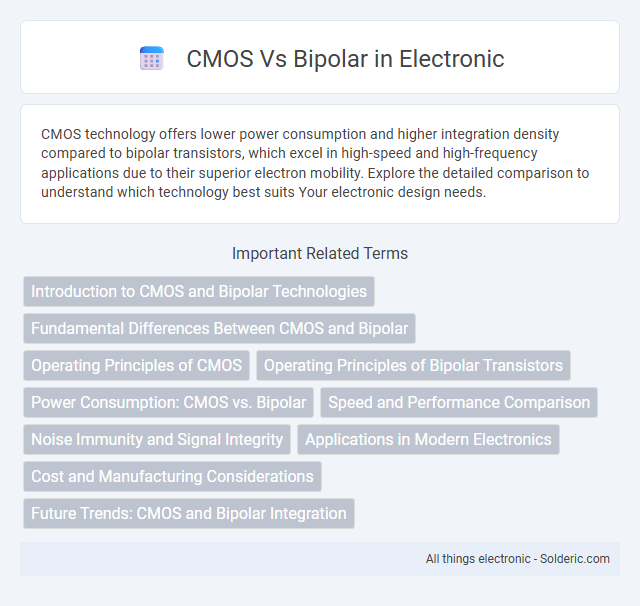CMOS technology offers lower power consumption and higher integration density compared to bipolar transistors, which excel in high-speed and high-frequency applications due to their superior electron mobility. Explore the detailed comparison to understand which technology best suits Your electronic design needs.
Comparison Table
| Feature | CMOS (Complementary Metal-Oxide-Semiconductor) | Bipolar Junction Transistor (BJT) |
|---|---|---|
| Technology | Uses both PMOS and NMOS transistors | Uses bipolar junction transistors (NPN or PNP) |
| Power Consumption | Low static power consumption | Higher power consumption, especially static |
| Switching Speed | Moderate switching speed | High switching speed |
| Noise Tolerance | Lower noise immunity | Higher noise tolerance |
| Integration Density | High integration density, suitable for complex ICs | Lower integration density |
| Cost | Generally lower cost for mass production | Higher cost due to complexity |
| Applications | Microprocessors, memory chips, digital circuits | Amplifiers, RF circuits, analog applications |
Introduction to CMOS and Bipolar Technologies
CMOS technology, primarily used in digital integrated circuits, offers high noise immunity and low power consumption by utilizing complementary pairs of p-type and n-type MOSFETs. Bipolar technology, built on bipolar junction transistors (BJTs), excels in high-speed analog applications due to its superior current driving capabilities and fast switching. Understanding the fundamental differences between CMOS and bipolar transistors is crucial for optimizing performance in mixed-signal and high-frequency circuits.
Fundamental Differences Between CMOS and Bipolar
CMOS technology uses complementary pairs of p-type and n-type MOSFETs to achieve low static power consumption and high noise immunity, whereas Bipolar technology relies on BJTs (bipolar junction transistors) that provide high-speed switching and greater current drive capability. CMOS circuits operate primarily with voltage-driven inputs and have high input impedance, while Bipolar circuits are current-driven and exhibit lower input impedance. Your choice between CMOS and Bipolar depends on the required power efficiency, speed, and analog performance characteristics of the application.
Operating Principles of CMOS
CMOS technology operates by using complementary and symmetrical pairs of p-type and n-type MOSFETs to achieve low power consumption and high noise immunity. Your circuits benefit from the CMOS principle since it only draws significant current when switching states, making it ideal for battery-powered devices. This principle allows CMOS devices to outperform bipolar transistors in terms of energy efficiency and heat dissipation.
Operating Principles of Bipolar Transistors
Bipolar transistors operate based on the injection and control of charge carriers across the emitter-base junction, utilizing both electrons and holes for conduction, which enables high current gain and fast switching. The transistor's operation depends on the forward bias of the emitter-base junction and reverse bias of the base-collector junction, facilitating charge flow from the emitter to the collector through the base region. This charge carrier movement and recombination determine the transistor's amplification properties, distinguishing bipolar devices from CMOS technology that relies on field-effect principles.
Power Consumption: CMOS vs. Bipolar
CMOS technology offers significantly lower power consumption compared to bipolar devices due to its high input impedance and static power draw primarily during switching events. Bipolar transistors consume more power because of continuous current flow through the base-emitter junction even in the active state. Your choice between CMOS and bipolar circuits can greatly impact energy efficiency, especially in battery-powered or low-power applications.
Speed and Performance Comparison
CMOS technology offers lower power consumption and higher integration density, making it ideal for high-speed, low-power applications, while bipolar transistors excel in high-frequency, high-gain performance due to their faster switching speeds. Bipolar junction transistors (BJTs) provide superior analog performance and high current drive capabilities compared to CMOS, which is advantageous in RF and analog circuits requiring rapid response. Despite bipolar's speed advantages in specific applications, CMOS processes have achieved significant improvements through scaling and advanced fabrication, enabling competitive speed and efficient digital performance in modern integrated circuits.
Noise Immunity and Signal Integrity
CMOS technology offers superior noise immunity due to its high input impedance and low static power consumption, which helps minimize susceptibility to electrical noise and interference. Bipolar devices, while providing faster switching speeds and higher gain, often exhibit greater noise levels because of higher current flow and lower input impedance. Your choice between CMOS and Bipolar should consider the critical need for signal integrity in noisy environments, with CMOS generally favored for clean, low-noise signal processing applications.
Applications in Modern Electronics
CMOS technology dominates modern electronics with applications in microprocessors, memory chips, and digital logic circuits due to its low power consumption and high noise immunity. Bipolar transistors excel in analog applications such as RF amplifiers and high-speed switching because of their superior current handling and fast response times. Your choice between CMOS and bipolar devices hinges on balancing power efficiency against high-frequency performance requirements.
Cost and Manufacturing Considerations
CMOS technology generally offers lower manufacturing costs due to its simpler process and higher integration density, making it ideal for cost-sensitive applications. Bipolar devices require more complex fabrication steps, increasing production expenses and limiting scalability. When optimizing your design for cost efficiency and manufacturing ease, CMOS is often the preferred choice.
Future Trends: CMOS and Bipolar Integration
Future trends in semiconductor technology emphasize the integration of CMOS and Bipolar devices to leverage CMOS's low power and high-density advantages alongside Bipolar's superior analog performance and high-speed operation. BiCMOS technology, combining CMOS and Bipolar transistors on a single chip, is gaining traction for applications requiring mixed-signal processing, RF amplification, and high-frequency communication. Advances in nanoscale fabrication and heterogeneous integration techniques are driving enhanced performance, energy efficiency, and miniaturization in BiCMOS circuits for next-generation electronics.
CMOS vs Bipolar Infographic

 solderic.com
solderic.com